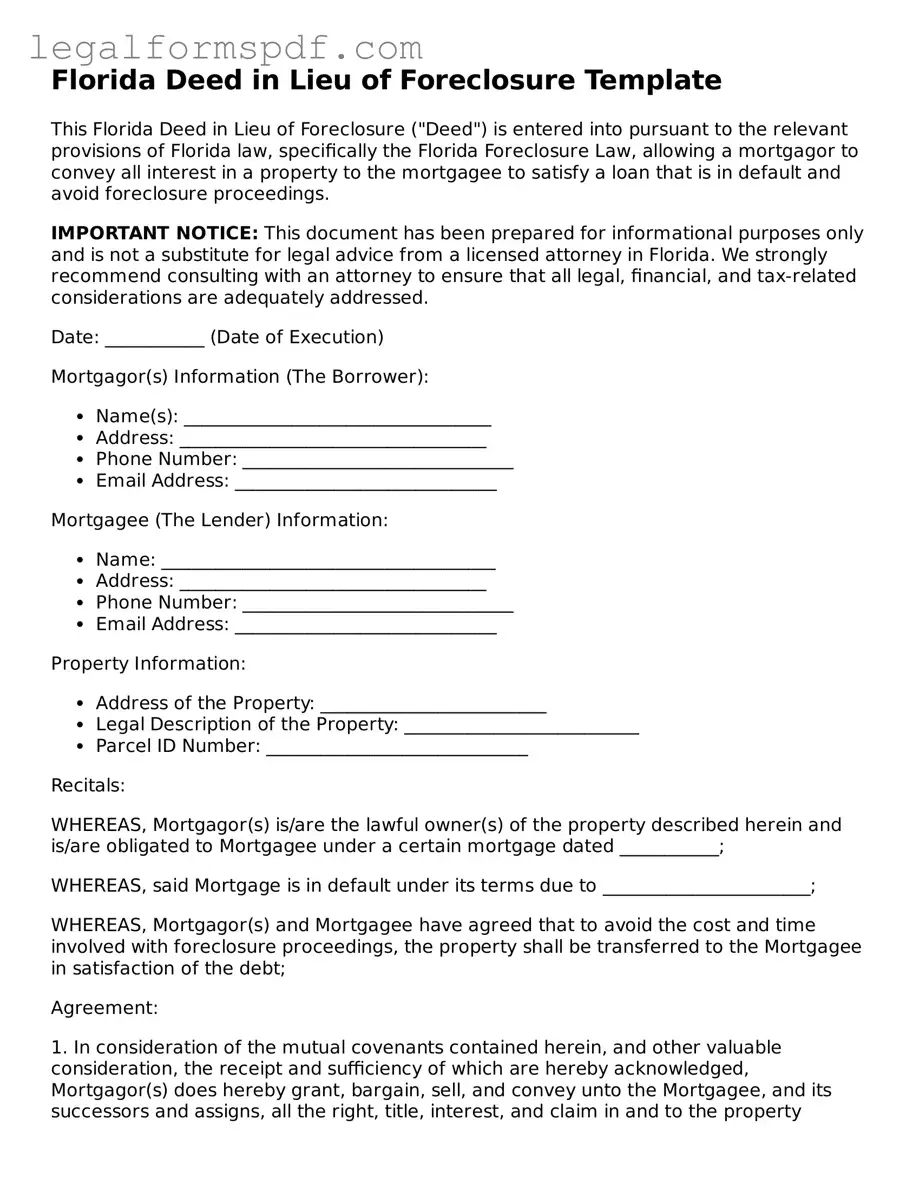Florida Deed in Lieu of Foreclosure Template
This Florida Deed in Lieu of Foreclosure ("Deed") is entered into pursuant to the relevant provisions of Florida law, specifically the Florida Foreclosure Law, allowing a mortgagor to convey all interest in a property to the mortgagee to satisfy a loan that is in default and avoid foreclosure proceedings.
IMPORTANT NOTICE: This document has been prepared for informational purposes only and is not a substitute for legal advice from a licensed attorney in Florida. We strongly recommend consulting with an attorney to ensure that all legal, financial, and tax-related considerations are adequately addressed.
Date: ___________ (Date of Execution)
Mortgagor(s) Information (The Borrower):
- Name(s): __________________________________
- Address: __________________________________
- Phone Number: ______________________________
- Email Address: _____________________________
Mortgagee (The Lender) Information:
- Name: _____________________________________
- Address: __________________________________
- Phone Number: ______________________________
- Email Address: _____________________________
Property Information:
- Address of the Property: _________________________
- Legal Description of the Property: __________________________
- Parcel ID Number: _____________________________
Recitals:
WHEREAS, Mortgagor(s) is/are the lawful owner(s) of the property described herein and is/are obligated to Mortgagee under a certain mortgage dated ___________;
WHEREAS, said Mortgage is in default under its terms due to _______________________;
WHEREAS, Mortgagor(s) and Mortgagee have agreed that to avoid the cost and time involved with foreclosure proceedings, the property shall be transferred to the Mortgagee in satisfaction of the debt;
Agreement:
1. In consideration of the mutual covenants contained herein, and other valuable consideration, the receipt and sufficiency of which are hereby acknowledged, Mortgagor(s) does hereby grant, bargain, sell, and convey unto the Mortgagee, and its successors and assigns, all the right, title, interest, and claim in and to the property described above, free and clear of all liens and encumbrances, except for the following: _____________.
2. Mortgagor(s) represents and warrants that the Mortgagor(s) has the full power and authority to transfer the property and that the property is free of all liens and encumbrances except as noted herein.
3. This Deed is executed as a deed in lieu of foreclosure and upon recording shall extinguish all rights, title, interest, and claims of the Mortgagor(s) in the property.
GOVERNING LAW: This Deed shall be governed, construed, and enforced in accordance with the laws of the State of Florida, without regard to its conflict of laws rules.
IN WITNESS WHEREOF, the parties hereto have executed this Deed as of the date first above written.
Mortgagor(s) Signature: _____________________________
Mortgagee Signature: ______________________________
State of Florida
County of ___________
On this ___ day of ___________, 20__, before me, the undersigned notary public, personally appeared ___________________________, known to me (or satisfactorily proven) to be the person(s) whose name(s) is/are subscribed to the within instrument and acknowledged that he/she/they executed the same for the purposes therein contained.
IN WITNESS WHEREOF, I hereunto set my hand and official seal.
Notary Public: ______________________________
My Commission Expires: ________________________
